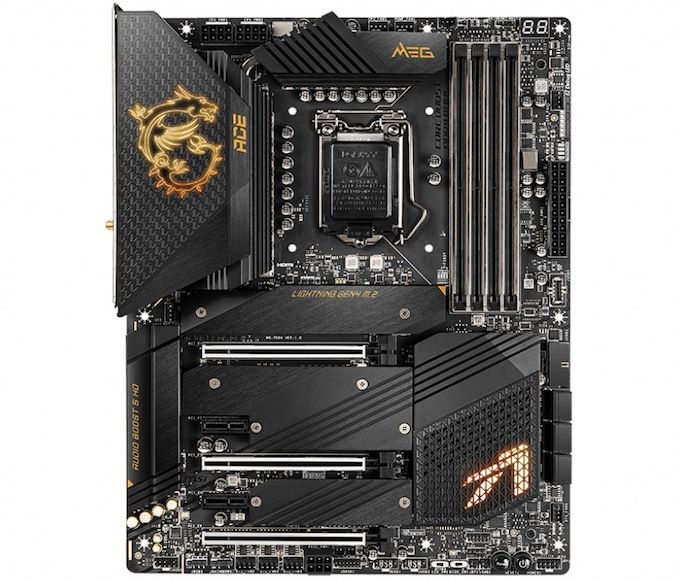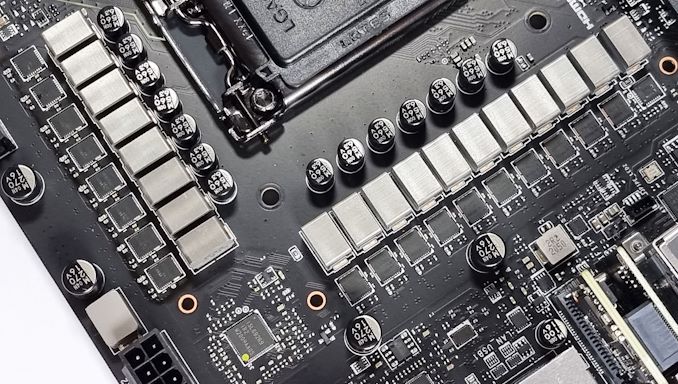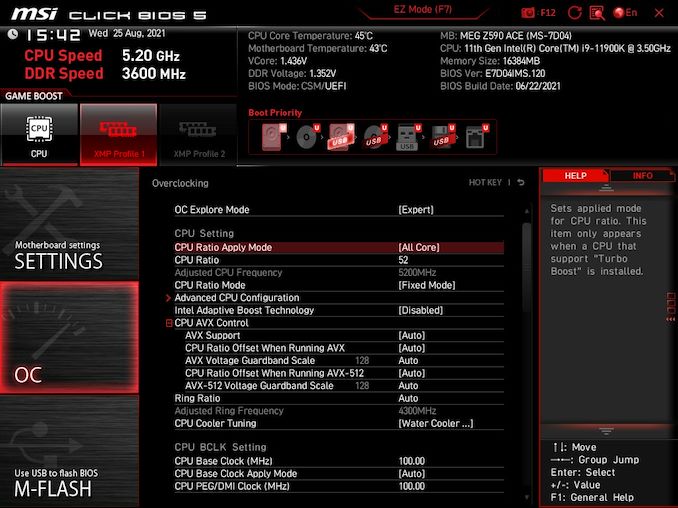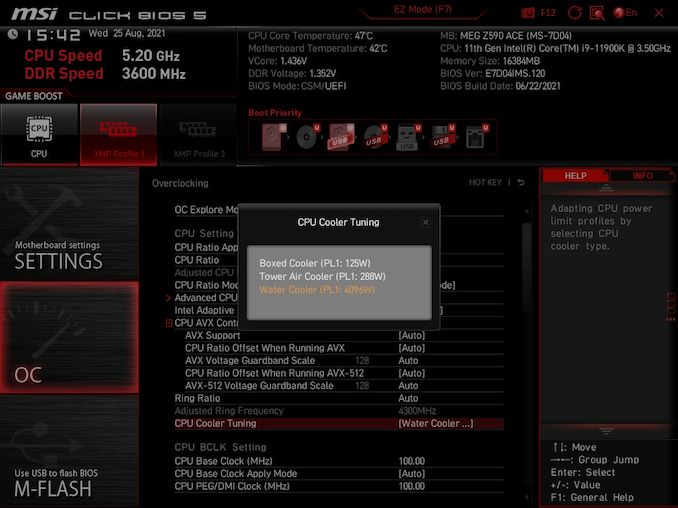Multi-chip Intel Core i9-11900K Overclocking Review: Four Boards, Cryo Cooling
by Gavin Bonshor on August 30, 2021 9:00 AM ESTThe MSI MEG Z590 Ace: A Quick Recap
Click here for the full review
The MSI MEG Z590 Ace is a premium ATX motherboard and sits just below its flagship MEG Z590 Godlike model, which is currently one of the best boards on the Z590 chipset. Looking at the countless number of features the Ace has up its sleeve, it has two full-length PCIe 4.0 slots operating at x16 and x8/x8, a third full-length slot electronically locked down to PCIe 3.0 x4, and two PCIe 3.0 x1 slots. The MSI MEG Z590 Ace also has four memory slots located in the top right-hand corner with support for up to DDR4-5600, which is one of the highest QVL'ed boards on Z590 and can accommodate up to 128 GB in terms of capacity.

Focusing on storage, the Ace has four PCIe M.2 ports, including one with support for PCIe 4.0 x4, one with support for PCIe 3.0 x4 M.2 drives, and two with support for both PCIe 3.0 x4 and SATA M.2 drives. MSI also includes six SATA ports, including support for RAID 0, 1, 5, and 10 arrays. Regarding onboard audio, the Ace is using Realtek's latest ALC4082 HD audio codec and is assisted by an ESS Sabre 9018Q2C DAC. Looking at the premium controller set, the Ace uses an Intel Maple Ridge Thunderbolt 4 controller, which powers two Type-C and two mini-DisplayPort video inputs on the rear panel. In terms of networking, there is an Intel AX210 Wi-Fi 6E CNVi and an Intel I225-V 2.5 GbE port.
MSI MEG Z590 Ace Key Overclocking Variables
Some of the most notable elements of the Ace when it comes to features helpful to overclocks are as follows:
- Premium 18-phase power delivery operating at 8+2 (doubled design)
- 2 x 8-pin 12 V ATX CPU power inputs + 1 x 6-pin PCIe power input
- Solid power delivery heatsink design
- Support for DDR4-5600 out of the box (one of the best on Z590)
Looking specifically at the power delivery on the MSI MEG Z590 Ace, the 18-phase design uses an Intersil ISL69269 PWM controller operating at 8+2. The CPU section uses sixteen Intersil ISL99390 90 A premium power stages, which is doubled up with eight Intersil ISL6617A doublers. For the CPU section, MSI is using two Renesas RAA220075 75 A power stages.

The 18-phase power delivery on the MSI MEG Z590 Ace (operating at 8+2)
Keeping the large 18-phase power delivery cool is a pair of heatsinks interconnected by a single heat pipe. The heatsinks themselves have deep channeled grooves designed to direct and catch adequate airflow within a chassis effectively. The main area cooling the bulk of the CPU section also benefits by being attached to a large metal rear panel cover, which adds a large surface area to dissipate heat.
MSI MEG Z590 Ace Firmware for Overclocking: OC
The MEG Z590 Ace uses MSI's commonly used Click BIOS 5 firmware, so the overall look and design are consistent across all of its recent (circa 3-years) models. Like with all the models we have on test for this article, the MSI Click BIOS 5 also has an 'EZ' mode and an 'Advanced' mode which users can cycle between by pressing the F7 key. Regarding the GUI, the Ace firmware has a black background, grey paneling for the sub-menus, and white text and red accents.
All of MSI's overclocking options can be found within the OC menu within the Advanced mode and has plenty of options for users to play with. To simply overclock the CPU, users can adjust the CPU ratio to the defined ratio in increments of 100 MHz, e,g 51 = 5.1 GHz, and adjust the CPU VCore. Under the Advanced CPU options are a whole host of settings, including a mode for Extreme OC with sub-ambient cooling such as liquid nitrogen (LN2) and dry ice (DICE), as well as Intel's Turbo Boost settings and other power-saving (or power increasing) settings to flick between. For overclocking memory, users can enable memory with X.M.P 2.0 profiles at the click of a button and fine-tune latencies and push frequency/voltage. MSI also includes a whole host of predefined memory profiles for users with high bin memory kits, including Samsung, Hynix, and Micron.
As well as providing lots of Intel Thermal Velocity Boost (TVB) and Intel Adaptive Boost Technology (ABT) options for users to tweak, but it has a handy CPU cooler section menu. Within this menu, users can select the type of cooling for less or more aggressive power limit settings, with the water cooler unlocking all the PL1 and PL2 power limits to 4096 W for maximum performance.
The MSI Click BIOS 5 firmware is a testament to keeping things consistent throughout all of its desktop options, whether that be the AMD or Intel models. MSI keeps all of its overclocking options in one easy-to-navigate menu, with a long list and plenty of sub-menus for users to explore. Most importantly of all, overclocking on MSI's Z590 models is easy as can be due to the CPU cooler selection menu, which can set the power profiles automatically depending on how good the cooling is.
Getting a baseline on stability and maximum all-core frequencies using the MSI MEG Z590 Ace with all four Core i9-11900K's, we achieved the following:
| Achieved Stable Overclock on Each Core i9-11900K | ||
| Intel Core i9-11900K Sample | Achieved All-Core CPU Frequency |
Achieved CPU VCore Voltage (V) |
| Chip #1 - Batch V051F933 | 5.2 GHz | 1.440 V |
| Chip #2 - Batch V051F933 | 5.2 GHz | 1.460 V |
| Chip #3 - Batch V051F933 | 5.2 GHz | 1.470 V |
| Chip #4 - Batch X101J374 | 5.2 GHz | 1.460 V |
Binning our four Core i9-11900K's using the MSI MEG Z590 Ace, all four were able to achieve an all-core overclock of 5.2 GHz with a CPU VCore between 1.440 and 1.470 W. As with other models we've tested in this article, chip #1, which incidentally is also our motherboard test bench chip, is our best overclocker with lower volts required than the other three chips.
In our VRM thermal testing during our full review of the board, we got the following results with the MSI MEG Z590 Ace with Chip #1 at 5.1 GHz with 1.450 V:
- VRM Sensor Temp: 69°C
- VRM Probe 1: 73°C
- VRM Probe 2: 75°C
- Ambient Temp: 23°C
In our power delivery thermal testing within the full review of the MSI MEG Z590 Ace, we saw very competitive performance against the other Z590 models on test. Despite MSI opting for a fully passive cooling design on the power delivery, the thermal performance was on par with the Z590 Taichi which is using an active design.












54 Comments
View All Comments
yeeeeman - Tuesday, August 31, 2021 - link
don't wanna be closed in an ecosystemikjadoon - Monday, August 30, 2021 - link
424 W under peak nT overclocked load. Those VRMs were earning their stripes!53W per core. Per core!
Is there a reason besides voltage why Chip #3 significantly beat Chips #1, 2 in POV-Ray + Cinebench R23 nT + GB5 nT on the Z590 HERO ? All were 5.2 GHz. Higher voltage = better clock stability?
//
Is it a typo or a really good deal on the first page chart at the bottom—i9-11900K to be $374, though earlier written as $545.
ceomrman - Monday, August 30, 2021 - link
This is a great article, nice work! The gains are very modest, but more surprising to me was how variable they were. As a consumer buying top-shelf parts, you could easily end up with worse overclocked performance than you'd get at stock settings with a different random CPU and/or expensive, high quality motherboard. Even for uses that would benefit from overclocking, there are very specific configuration choices to navigate. That's not to mention that the kind of tasks that would benefit from absolute max multi-core performance are noticeable faster on a Ryzen or even on older Intel HEDT chips with more cores, anyway. The 11900K is for gaming. Overclocking it yields no gaming improvement. So yeah, don't bother.mode_13h - Monday, August 30, 2021 - link
> using current average US energy prices, assuming the system was at full-load for the> full duration, 10 hours a day over 300 days a year equates to an extra $41 in energy bills.
Please specify what figure you're using for "current average US energy prices". They vary by a lot (in terms of location, time of day (for some), and time of year).
Also, it'd be worth noting that you're not taking into account additional A/C costs. During the winter, some might not need air conditioning, although electric heat is nearly always more expensive that gas or oil (making this an inefficient substitute). However, during the summer, if the A/C is already taxed, the marginal increase in power utilization is probably nonlinear.
Although this sort of matrix testing sheds a little light into variations between boards and CPUs, you should probably use multiple samples of each board to draw any strong inferences about them. More importantly, I think a greater number of readers would be better-served by doing a proper GPU review.
mode_13h - Monday, August 30, 2021 - link
BTW, when estimating energy costs, did you account for PSU losses? If we assume the PSU is 80+ Platinum and running near full-load, it'd amount to another 11% or so.TheinsanegamerN - Monday, August 30, 2021 - link
"The average electricity rate is 13.19 cents per kilowatt hour (kWh)."https://www.electricchoice.com/electricity-prices-...
Dug - Monday, August 30, 2021 - link
"map provides a good representation"Well every site has different averages, so it's misleading.
And most are done by location, not by population. So 100 people paying 9cents and 1 million paying 13cents averages out to 11cents. Which isn't a realistic average.
mode_13h - Tuesday, August 31, 2021 - link
I typically pay about twice that.And if we consider the case of Texas, they typically have lower energy prices. However, during peak-demand season, the spot price really shoots up. During the summer, A/C is so essential that people there will cut back on food expenditures before they completely forego air-conditioning.
Wrs - Monday, August 30, 2021 - link
Or you could back-calculate what kWh rate they were assuming. I suspect a miscalculation somewhere by the quoted… In any case, a TEC is horribly inefficient for substantial active load, and in this case rather ineffective due to being undersized. 200w for 88 C at approx. 300w heat load? Just get a faster water pump to beat that with ambient liquid cooling. Electric cost would be pennies on the dollar!thestryker - Monday, August 30, 2021 - link
It sure seems like some sort of adaptive core overclocking would be key on these processors. On my 6800k, and now 6900k, I definitely have my overclock set for 2 and all cores just to keep the voltage down, but gain extra clockspeed for lightly threaded. It's not perfect, but assuming this type of setup works on z590 properly it would at the very least keep that stock boost if not allow for higher.In general from what I've read regarding both AMD and Intel's recent processors though it just seems like overclocking for a daily driver just isn't particularly worth it. Maybe with the upcoming ADL there'll be something extra to squeeze out of the E cores, but otherwise the future sure seems like minimal OC gains.